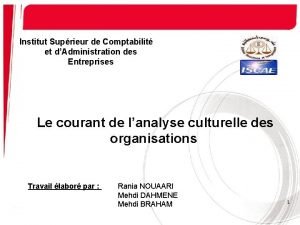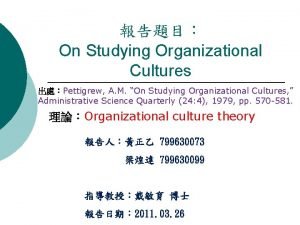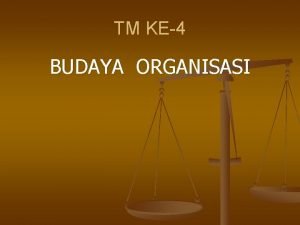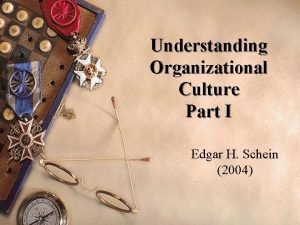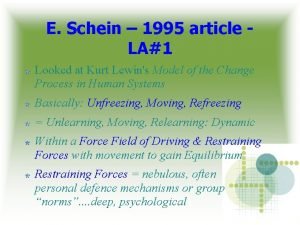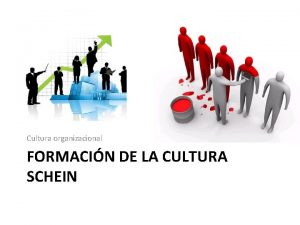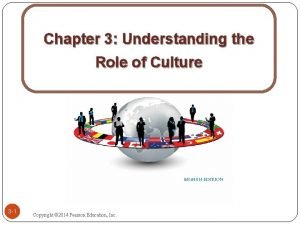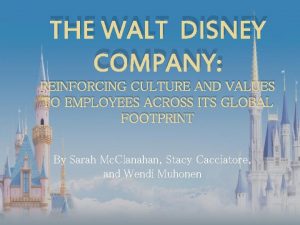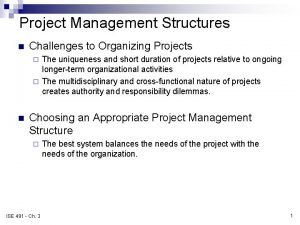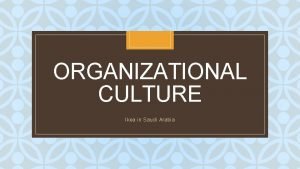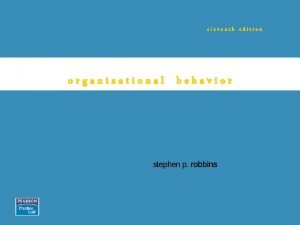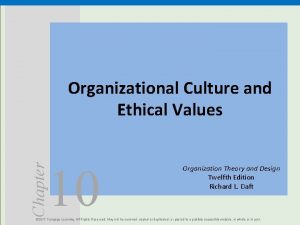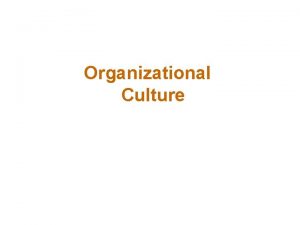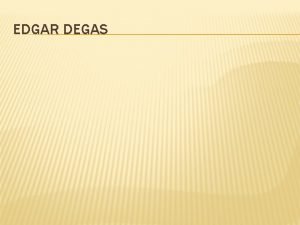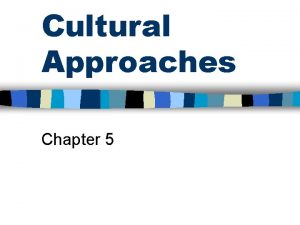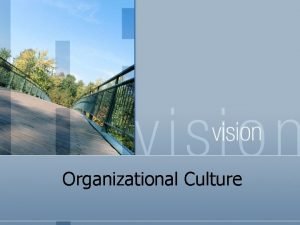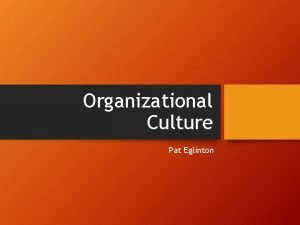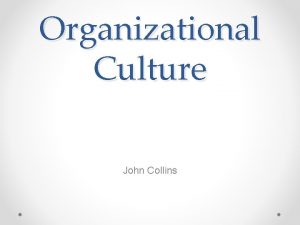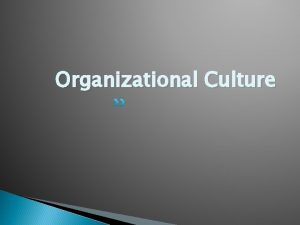Understanding Organizational Culture Part I Edgar H Schein



















- Slides: 19

Understanding Organizational Culture Part I Edgar H. Schein (2004)

CULTURE AND ORGANIZATION LEARNING COOK AND YANOW, 1993 The Powell Flute Company - 2007

Misconceptions about Organizational Culture w “Culture” = Sophistication w Anthropological view: Culture = Rituals and Customs w Org research view – A “right” kind of culture – Some cultures are better than others (surveys) – Stronger culture = Better performance

Abstract Nature of Culture w Organizational culture describes phenomena that are often hidden and below the surface of observable behavior w Culture is within us as individuals (learned behavior in family, peer groups, occupation), yet constantly evolving as we join and create new groups

Culture and Leadership “Culture and leadership are two sides of the same coin in that leaders first create cultures when they create groups and organizations. ” What do you think he means?

Attributes of Culture w Begins with leaders who impose their values and assumptions on a group w If the group is successful, assumptions come to be taken for granted as the “right” way to do things w Results in a culture that now defines what type of leadership is effective

Attributes of Culture w If group runs into adaptive difficulties (the environment changes internally or externally), some of these taken-for-granted assumptions may no longer be valid w Leadership now becomes the ability to step “outside” the culture and initiate change processes that are adaptive to the new reality

“The bottom line for leaders is that if they do not become conscious of the cultures in which they are embedded, those cultures will manage them. ” Edgar H. Schein, 2004

Shared Attributes of Organizational Culture w Observed behavioral regularities w Group norms w Espoused values w Formal philosophy w “Rules of the game” w w w Climate Embedded skills Habits of thinking Shared meanings “Root metaphors” Formal rituals and celebrations

Characteristics of Culture w Structural Stability – Stable, as well as “shared” – Culture survives when members of the org do not w Depth – Deepest, often unconscious part of group life; less tangible and less visible

Characteristics of Culture w Breadth – Pervasive; influences all aspects of the organization w Patterning or Integration – Forms a “gestalt” or whole to create orderliness in the organization – Reduces ambiguity – Permits sensemaking

Culture Defined A pattern of shared basic assumptions that was learned by a group as it solved its problems of external adaptation and internal integration, that has worked well enough to be considered valid and, therefore, to be taught to new members as the correct way to perceive, think, and feel in relation to those problems.

Three Levels of Culture Artifacts Espoused Values Underlying Assumptions

Artifacts: visible organizational structures and processes, such as. . . w Dress code w Names and titles of people and how they are used w Formality or informality in speaking w Degree of emphasis on automation w Perks such as parking, other benefits w Traditions upheld w Working hours

Espoused Values: established group values and beliefs such as. . . w Slogans, mottos w Mission statements or code of ethics w Statements about commitment to excellence (or customer service, etc) w Overt and professed beliefs about how employees and customers are treated

Basic Underlying Assumptions: beliefs and attitudes so taken for granted that they are not often articulated w Most difficult to change because rarely re-examined w Similar to what Argyris calls “theories in use” w Represent a shared “mental map” w Represent the most powerful aspect of organizational culture

How does a new group create a culture?

Each member of a new group will bring his or her own cultural learning from a prior group. As the new group develops its own shared history, it will develop modified or brandnew assumptions based on what is successful in its own experience. These new assumptions create the culture of the new group.

What do you see as the artifacts and espoused values at Enron from the movie? What “appear” to be basic underlying assumptions in operation? How would you go about finding out more about these underlying assumptions to ascertain if what you have surmised is correct?
 Edgar schein culture d'entreprise
Edgar schein culture d'entreprise On studying organizational cultures
On studying organizational cultures Edgar schein teori
Edgar schein teori Edgar schein 2004
Edgar schein 2004 Edgar schein kulturmodell
Edgar schein kulturmodell Schein three levels of culture examples
Schein three levels of culture examples Eduardo bassini
Eduardo bassini Schein 1995
Schein 1995 Modelo de schein
Modelo de schein Schein
Schein Schein's model
Schein's model Urlaubplanung
Urlaubplanung Modelo burke litwin
Modelo burke litwin Understanding the role of culture
Understanding the role of culture Disney company core values
Disney company core values Organizational culture diagnosis worksheet
Organizational culture diagnosis worksheet Ikea artifacts
Ikea artifacts Customer responsive organization
Customer responsive organization In an inert organizational culture,
In an inert organizational culture, Ethical corporate culture
Ethical corporate culture
